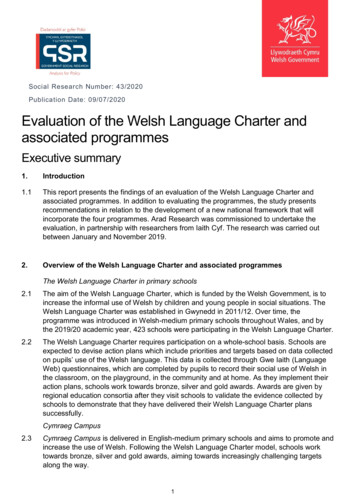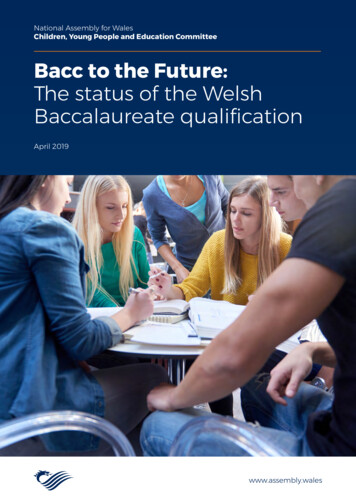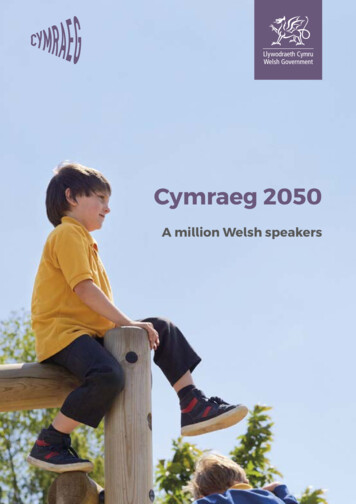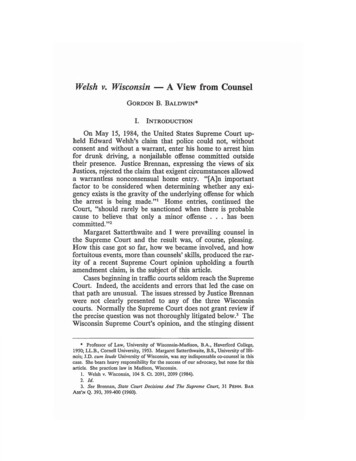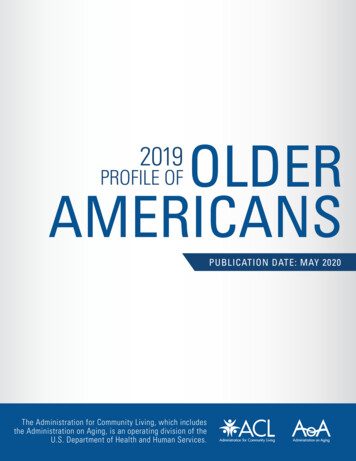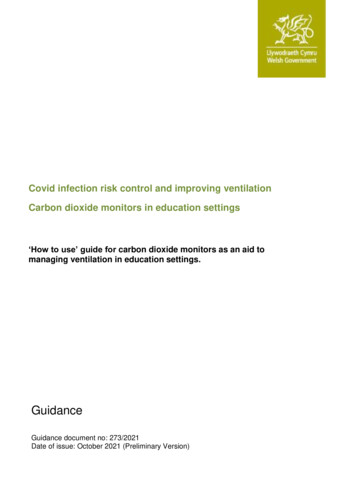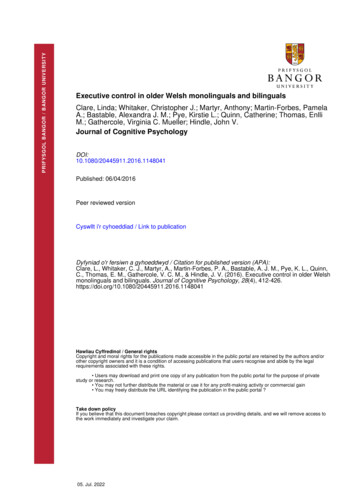
Transcription
PRIFYSGOL BANGOR / B ANGOR UNIVERSITYExecutive control in older Welsh monolinguals and bilingualsClare, Linda; Whitaker, Christopher J.; Martyr, Anthony; Martin-Forbes, PamelaA.; Bastable, Alexandra J. M.; Pye, Kirstie L.; Quinn, Catherine; Thomas, EnlliM.; Gathercole, Virginia C. Mueller; Hindle, John V.Journal of Cognitive ed: 06/04/2016Peer reviewed versionCyswllt i'r cyhoeddiad / Link to publicationDyfyniad o'r fersiwn a gyhoeddwyd / Citation for published version (APA):Clare, L., Whitaker, C. J., Martyr, A., Martin-Forbes, P. A., Bastable, A. J. M., Pye, K. L., Quinn,C., Thomas, E. M., Gathercole, V. C. M., & Hindle, J. V. (2016). Executive control in older Welshmonolinguals and bilinguals. Journal of Cognitive Psychology, 28(4), 041Hawliau Cyffredinol / General rightsCopyright and moral rights for the publications made accessible in the public portal are retained by the authors and/orother copyright owners and it is a condition of accessing publications that users recognise and abide by the legalrequirements associated with these rights. Users may download and print one copy of any publication from the public portal for the purpose of privatestudy or research. You may not further distribute the material or use it for any profit-making activity or commercial gain You may freely distribute the URL identifying the publication in the public portal ?Take down policyIf you believe that this document breaches copyright please contact us providing details, and we will remove access tothe work immediately and investigate your claim.05. Jul. 2022
Bilingualism and executive controlExecutive control in older Welsh monolinguals and bilingualsLinda Clare*1, Christopher J Whitaker2, Anthony Martyr1, Pamela A Martin-Forbes3,4, Alexandra JM Bastable2, Kirstie L Pye2, Catherine Quinn1, Enlli M Thomas3, Virginia C Mueller Gathercole5,& John V Hindle2,3,61.2.3.4.University of Exeter, Exeter, UKNorth Wales Organisation for Randomised Trials in Health, Bangor University, Bangor, UKBangor University, Bangor, UKNational Institute for Social Care and Health Research Clinical Research Centre, NorthWales Research Network, Bangor, UK5. Florida International University, Miami, USA6. Betsi Cadwaladr University Health Board, Llandudno Hospital, Conwy, UK*Corresponding authorProfessor Linda Clare, Dr Anthony Martyr, & Dr Catherine QuinnCentre for Research in Ageing and Cognitive Health (REACH), School of Psychology, Universityof Exeter, Exeter EX4 4QG, United KingdomEmail: l.clare@exeter.ac.uk; phone: 44 1392 724659Email: a.martyr@exeter.ac.uk; phone: 44 1392 726863Email: c.quinn@exeter.ac.uk; phone: 44 1392 726861Web: http://psychology.exeter.ac.uk/reach/Christopher John Whitaker, Kirstie Louise Pye & Alexandra Jane Mary BastableNorth Wales Organisation for Randomised Trials in Health, Bangor University, Bangor, Gwynedd,LL57 2PZ, United KingdomEmail: c.j.whitaker@bangor.ac.uk; phone: 44 1248 383218Email: a.bastable@bangor.ac.uk; phone: 44 1248 383792Email: k.pye@bangor.ac.uk; phone: 44 1248 382224Dr Pamela Ann Martin-ForbesNational Institute for Social Care and Health Research Clinical Research Centre, North WalesResearch Network, School of Medical Sciences, Bangor University, Bangor, Gwynedd, LL57 2AS,United KingdomEmail: p.martin-forbes@bangor.ac.uk; phone: 44 1248 388719Dr Enlli Mon ThomasSchool of Education, Bangor University, Normal Site, Bangor, Gwynedd, LL57 2PZ, UnitedKingdomEmail: enlli.thomas@bangor.ac.uk; phone: 44 1248 383962Professor Virginia C Mueller GathercoleEnglish Department, Florida International University, Miami, Florida 33199, United States ofAmericaEmail: vmueller@fiu.edu; Phone: 1 305-348-63901
Bilingualism and executive controlDr John Vincent HindleBetsi Cadwaladr University Health Board, Llandudno Hospital, Conwy, LL30 1LB, UnitedKingdom.Email: j.v.hindle@bangor.ac.uk; phone: 44 1492 862366The research was conducted at Bangor University, UK.For information on how to access the BANC dataset, see http://psychology.exeter.ac.uk/reach/data/Funding: The BANC study was supported by the Economic and Social Research Council undergrant RES-062-23-1931 to Linda Clare (CI), John Hindle, Fergus Craik, Ellen Bialystok, ChrisWhitaker, Enlli Thomas and Virginia Gathercole.Acknowledgements: We are grateful to Lester Bath for administrative support, Dr David Hunnisettfor assistance with data management, Dr Zoe Hoare for statistical advice, and Professor MargaretDeuchar for supporting the study. We thank Professor Fergus Craik and Professor Ellen Bialystokfor generously sharing their expertise in bilingualism research, for their advice, guidance andsupport during the BANC project, and for their valuable comments on earlier drafts of thismanuscript.Disclosures: The authors report no conflicts of interest.Word count: text 6728; abstract 1502
Bilingualism and executive controlAbstractEvidence for a bilingual advantage in executive control has led to the suggestion that beingbilingual might protect against late-life cognitive decline. We assessed the performance of sociallyhomogeneous groups of older ( 60 years) bilingual Welsh/English (n 50) and monolingualEnglish (n 49) speakers on a range of executive control tasks yielding 17 indices for comparison.Effect sizes ( .2) favoured monolinguals on 10 indices, with negligible differences observed on theremaining 7 indices. Univariate analyses indicated that monolinguals performed significantly betteron two of 17 indices. Multivariate analysis indicated no significant overall differences between thetwo groups in performance on executive tasks. Older Welsh bilinguals do not show a bilingualadvantage in executive control, and where differences are observed, these tend to favourmonolinguals. A possible explanation may lie in the nature of the sociolinguistic context and itsinfluence on cognitive processing in the bilingual group.KeywordsCognitive agingCognitive reserveInhibitionResponse conflictWorking memory3
Bilingualism and executive controlWith increasing longevity and an expanding older population, identification of factors that can helpto maintain cognitive health and reduce cognitive decline in later life is vitally important. It hasbeen argued that a range of psychosocial factors, including lifelong level of cognitive, social andphysical activity and size and complexity of social networks, may slow the development or reducethe impact of cognitive decline in later life (Williams, Plassman, Burke, Holsinger, & Benjamin,2010). Under the cognitive reserve hypothesis (Stern et al., 2003), engagement in complex mentalactivity over the lifespan, reflecting an active cognitive lifestyle, builds a capacity that helps tomaintain cognitive function in older age (Valenzuela & Sachdev, 2006), although it has also beensuggested that those with more resilient brains may engage in more complex mental activity(Salthouse, 2006). A decline in frontally-mediated executive function due to changes in frontostriatal circuits is a core component of the cognitive changes seen in healthy ageing (Buckner, 2004;Craik & Bialystok, 2006a). Executive function has been variously defined, conceptualised andmeasured (Hankee et al., 2013; Martyr & Clare, 2012; Royall, 1994; Salthouse, 2005), but it isgenerally acknowledged that the broad construct of executive function fractionates into a number ofspecific abilities. Recent research on executive function has focused in particular on the related butseparable domains of inhibition and management of response conflict, set-shifting and updating ofworking memory (Miyake & Friedman, 2012), although other domains such as mental flexibility,dual-task performance and planning are also important. Together these domains can be understoodin terms of executive control processes, ‘the set of fluid operations that enable intentionalprocessing and adaptive cognitive performance’ (Craik & Bialystok, 2006a, p. 131). Theseprocesses include the ability to selectively attend to important aspects of a problem, inhibit attentionto irrelevant or unhelpful information, and switch readily between possible alternative options orresponses.Recent evidence for a bilingual advantage in executive control processes (Bialystok, 2011) has ledto the suggestion that being bilingual might contribute to increased cognitive reserve (Bialystok,4
Bilingualism and executive controlCraik, & Luk, 2012), and learning a second language to a high standard may have a protectiveeffect on cognitive function in later life (Bak, Nissan, Allerhand, & Deary, 2014). The verbal skillsof bilinguals in each of their languages are often weaker than the skills of monolinguals in eachlanguage, and bilinguals typically achieve poorer scores on vocabulary, naming and fluency tasks(Bialystok, Craik, & Luk, 2008; Bialystok et al., 2012; Gollan, Fennema-Notestine, Montoya, &Jernigan, 2007). In contrast, however, several studies have shown that bilinguals outperformmonolinguals on non-linguistic tasks involving response conflict or the need to inhibit a learned orhabitual response, such as Simon, spatial Stroop or flanker (Bialystok, 2006; Costa, Hernandez, &Sebastian-Galles, 2008) tasks. On these tasks, bilinguals show smaller differences in reaction timebetween congruent and incongruent trials, indicative of a lower interference effect. A recentcomprehensive review (Hilchey & Klein, 2011) indicated that this interference effect was initiallythought to result from an inhibitory control advantage resulting from practice in switching betweentwo languages given that both languages of a bilingual are active continuously (Bialystok, 2011).The inhibitory control hypothesis was, however, called into question by the observation that, wherethe bilingual advantage is observed, bilinguals usually outperform monolinguals on both congruentand incongruent trials. This finding suggests that bilinguals have a more general advantage inexecutive processing, resulting in faster reaction times in tasks entailing some degree of responseconflict (Bialystok, 2006; Costa, Hernandez, Costa-Faidella, & Sebastian-Galles, 2009; Hilchey &Klein, 2011). Therefore, the current view is that this bilingual advantage arises because the generalexecutive control system is involved in language processing in order to deal with the conflictpresented by joint activation of the two languages. The extra practice gained in dealing with suchconflict means that the executive control system becomes more efficient in monitoring throughattending to and addressing situations requiring selection or conflict resolution (Bialystok, 2011;Costa et al., 2009; Gollan, Sandoval, & Salmon, 2011; Hilchey & Klein, 2011; Weissberger,Wierenga, Bondi, & Gollan, 2012). A recent systematic review focusing on studies conducted withchildren reported that bilingualism confers benefits in a range of domains, including attentional5
Bilingualism and executive controlcontrol, working memory, metalinguistic awareness, and abstract and symbolic representation skills(Adesope, Lavin, Thompson, & Ungerleider, 2010). A global bilingual executive processingadvantage could translate into greater cognitive reserve for bilingual individuals (Bialystok et al.,2012; Gold, 2015), providing increased protection against the effects of age-related brain pathology(Alladi et al., 2013; Bialystok, Craik, & Freedman, 2007). Recent evidence from neuroimagingstudies supports the view that lifelong bilingualism mitigates age-related decline in cognitivecontrol processes (Gold, Kim, Johnson, Kryscio, & Smith, 2013) and suggests that this results frombetter maintenance of white matter integrity and functional connectivity (Luk, Bialystok, Craik, &Grady, 2011).It has been suggested that, while the global advantage can be detected across the lifespan, theinterference effect is more evident in later life (Bialystok, Craik, Klein, & Viswanathan, 2004).Several studies with adults aged over 60 have yielded evidence for both the global advantage(Bialystok et al., 2004; Bialystok, Martin, & Viswanathan, 2005; Emmorey, Luk, Pyers, &Bialystok, 2008) and the interference effect (Bialystok et al., 2004; Bialystok et al., 2005; Emmoreyet al., 2008). A bilingual advantage is not always found, however, neither in children nor in youngadults (e.g. Duñabeitia et al., 2014; Kousaie, Sheppard, Lemieux, Monetta, & Taler, 2014; Paap &Greenberg, 2013), nor in the older age group where effects appear most robust (Kousaie & Phillips,2012; Kousaie et al., 2014). In addition, where the advantage is shown in experimental tasks, somestudies have suggested that it diminishes with practice (Costa et al., 2009; Costa et al., 2008).Therefore, further investigation of this phenomenon is warranted. It is important to note that thebilingual advantage in older people, where detected, has been demonstrated on a relatively limitedset of tasks, and it has been suggested that observed effects may be task-specific rather thanreflecting efficacy of general executive functioning (Paap, Johnson, & Sawi, 2015). If there is ageneral advantage in executive processing contributing to cognitive reserve, then bilinguals shouldshow better performance than monolinguals on a broad range of tasks for which executive control is6
Bilingualism and executive controlimportant (Hilchey & Klein, 2011). In partial support of this, in one study older bilingualsperformed better than monolinguals in planning, time allocation and task-switching on anecologically-valid ‘simulated cooking breakfast’ task (Craik & Bialystok, 2006b). There is a needtherefore to examine performance on a wider range of tasks (Paap et al., 2015), and this is a primaryaim of the present study.This study will examine the performance of older Welsh/English bilinguals and English-speakingmonolinguals on a broad range of tasks for which executive control is important, with the aim ofidentifying the cognitive profiles of the two groups across key domains of executive function andoutlining the implications for cognitive reserve. The importance of controlling for possibleconfounding factors, such as immigration and other relevant demographic variables, in comparisonsof monolingual and bilingual performance has frequently been emphasised. This is addressed asfully as possible in this study by recruiting from a socially and culturally homogenous communityin North Wales, United Kingdom, by controlling for socio-economic status and educational level ifdifferences between the groups are observed, and by further examining bilingual performance inrelation to the degree of use of the two languages in the bilingual group.MethodDesignThis cross-sectional cohort study compared healthy older Welsh/English bilingual and monolingualEnglish-speaking participants utilising experimental tasks, standardised neuropsychological testsand questionnaires. This investigation was part of the Bilingualism as a protective factor in Agerelated Neurodegenerative Conditions (BANC) study (Clare et al., 2014; Hindle et al., 2015), whichexamined the effects of bilingualism in people with Alzheimer’s disease and Parkinson’s disease,7
Bilingualism and executive controland in healthy older people. The study protocol was approved by the relevant University andNational Health Service ethics committees.ParticipantsParticipants were recruited in North Wales, United Kingdom. Wales is an officially bilingualconstituent nation of the United Kingdom, with a population of 3.1 million, of whom 96% are whiteBritish and 19% speak Welsh as well as English (Office for National Statistics, 2011; WelshGovernment, 2012). The counties of North Wales tend to have above average proportions of Welshspeakers, with the highest proportions in western areas: prevalence is 63% in Anglesey, 65% inGwynedd, 35% in Conwy, 31% in Denbighshire, 17% in Flintshire and 18% in Wrexham (Officefor National Statistics, 2011; Welsh Government, 2012).The participants were 99 individuals aged 60 or over, 49 monolingual and 50 bilingual. ‘Bilingual’was defined as speaking both English and Welsh for all or most of one’s life and being fluent inboth languages, but not in any additional languages. ‘Monolingual’ was defined as speaking Englishfor all of one’s life and being fluent in English, but not in any other language. To rule out thepresence of cognitive impairment, participants had to score 26 or above on the Mini-Mental StateExamination (MMSE; Folstein, Folstein, & McHugh, 1975) to be included in the study. Participantswere recruited through articles in English language newspapers, local Welsh-language newslettersand presentations to community groups. The majority of participants were drawn from the NorthWales counties of Anglesey (40), Gwynedd (37), Conwy (12) and Denbighshire (5), with theremaining 5 coming from other areas. North Wales is a predominantly rural area, and participants,whether monolingual or bilingual, mostly lived in small towns, villages or semi-rural locations.Language status was assessed with the Language Questionnaire - short version (Gathercole &Thomas, 2009). Responses indicated that the bilingual group had mostly grown up in Welsh-8
Bilingualism and executive controlspeaking homes; 47 (94%) had spoken Welsh from birth or before starting school, 40 (83%) saidtheir mother had always spoken to them in Welsh, and 42 (88%) said their father had always spokento them in Welsh. A smaller proportion had spoken English from birth or before starting school (15;31%), beginning to speak Welsh on starting school or during their primary education. On averagethey currently spoke Welsh about two-thirds of the time and English about one-third of the time.They were confident users of both languages, giving median scores of 5 on a 1 - 5 scale (where 1 islow and 5 is high) for ability to speak, understand, read and write in both Welsh and English. Thus,the bilingual group could be characterised as consisting of simultaneous or early sequentialbilinguals.None of the monolinguals reported use of any language other than English in their daily lives.Twenty-four monolinguals (49%) and 18 bilinguals (37%) indicated that they had some experienceof learning a language other than English or Welsh; in most cases this consisted of being taughtFrench in secondary school, acquiring some German during army service, or attending eveningclasses to learn holiday Spanish. In addition, in the monolingual group, 25 individuals (51%)indicated that they had engaged to a limited extent with learning the Welsh language at some timein the past. This occurred during secondary schooling for 4 people and in younger adulthood for 15people; non-Welsh speaking adults, some of whom will have moved from other areas of the UnitedKingdom, are encouraged to try to learn some basic Welsh, with language classes widely available.Engagement with Welsh had occurred during primary education for 3 people, and earlier for 3people who encountered some Welsh in the home environment at a young age; however, these 6individuals, due to changes in circumstances, had subsequently not developed their Welsh languageskills further and did not consider themselves to be Welsh speakers.9
Bilingualism and executive controlMeasuresBackground measuresInformation on age, gender, education and socio-economic status was collected. Health status wasassessed with the EQ-5D visual analogue scale (The EuroQol Group, 1990), functional ability withthe Instrumental Activities of Daily Living scale (Lawton & Brody, 1969), mood with the HospitalAnxiety and Depression Scale (Snaith & Zigmond, 1994), irregular word reading in English withthe National Adult Reading Test-Revised (Nelson & Willison, 1991), and cognitive status with theMMSE. The Lifetime of Experiences Questionnaire (scored according to Valenzuela & Sachdev,2007, with sample-derived weightings) provided a cognitive lifestyle score incorporatinginformation about education, occupation and engagement in cognitive, physical and social activitythroughout the lifespan, which served as a proxy measure of cognitive reserve.Tests of language abilityEnglish language proficiency was assessed with the 15-item version of the Boston Naming Test(Kaplan, Goodglass, & Weintraub, 1983), Spot-the-Word Test (Baddeley, Emslie, & NimmoSmith, 1992; Baddeley, Emslie, & Nimmo-Smith, 1993), and British Picture Vocabulary Scale(Dunn, Dunn, & Styles, 2009). Bilinguals additionally completed the Prawf Geirfa Cymraeg iOedolion (Welsh Vocabulary Test for Adults; Gathercole & Thomas, 2009), and responded to theBoston Naming Test in Welsh.Tests of executive functionFour domains of executive function were assessed, using standardised neuropsychological tests anda small number of experimental tasks which were either non-linguistic or drew to only a very basicdegree on linguistic skills. Tests were grouped a priori into domains on the basis of availableinformation about task characteristics and the type of executive abilities thought to be targeted by10
Bilingualism and executive controleach task. Mental generativity and speed were assessed with the Delis-Kaplan Executive FunctionSystem (D-KEFS) Design Fluency subtest - filled and empty dots conditions, and Trail Makingsubtest - number and letter sequencing conditions (Delis, Kaplan, & Kramer, 2001). Workingmemory was assessed with the Keep Track task (Lee, Ng, & Ng, 2009; Yntema & Mueser, 1962),and the Wechsler Memory Scale, Spatial Span subtest (Wechsler, 1997). Set-shifting and switchingwere assessed with the Test of Everyday Attention, Visual Elevator subtest (Robertson, Ward,Ridgeway, & Nimmo-Smith, 1994), D-KEFS Design Fluency subtest - switching condition, and DKEFS Trail Making subtest - switching condition (Delis et al., 2001). Inhibition and management ofresponse conflict were assessed with the Simon task (Simon, 1969; computerised version,Gathercole et al., 2010), Go-No Go task (McNab et al., 2008), Test of Everyday Attention, ElevatorCounting with Distraction subtest (Robertson et al., 1994), and Stroop Colour-Word Naming(Stroop, 1935; computerised version, Gathercole et al., 2010). Bilingual participants additionallycompleted a Welsh-language version of the Stroop task, not reported here, and the English andWelsh versions were administered in counterbalanced order; there were no significant differences inthe bilinguals’ mean response time difference scores on the English and Welsh versions for eithercolours or words, and in a three-way comparison of Stroop scores achieved on the English versionby monolinguals, bilinguals who completed the Welsh version first, and bilinguals who completedthe English version first there were also no significant between-group differences in mean responsetime difference scores for colours or words. Details of the computerised tasks can be found in Clareet al. (2014).ProcedureIndividuals expressing an interest in participating were visited by a researcher who explained thestudy further and sought informed consent. The assessment was then completed over two or threesessions. Participants were assessed either in their own homes or at the University, according to11
Bilingualism and executive controltheir preference. For bilingual participants, the structured interview was conducted in the languageof their choice, the Welsh-language measures were administered in a session conducted through themedium of Welsh (with the exception of the Welsh-language version of the Stroop task, which wasadministered together with the other computerised tasks, but with instructions given in Welsh), andthe remaining measures were administered in English.Statistical analysesMonolingual and bilingual groups were compared on socio-demographic factors and generalcognitive ability using analysis of variance (ANOVA), Chi-square or Mann-Whitney tests. Toprovide contextual information, the two groups were also compared on tests of language ability inEnglish using ANOVA. Performance on executive tasks within each of the four domains in the twogroups was compared using ANOVA, applying the Holm-Bonferroni correction for multiplecomparisons to all indices across the four domains, and effect sizes were calculated as thedifference between the means for monolingual and bilingual groups, divided by the square root ofthe error mean square term from the ANOVA table (the pooled standard deviation). This providesthe standardised mean difference. Multivariate analysis of variance (MANOVA) was applied tocompare monolingual and bilingual performance within each of the four groups of executive tasks(mental generativity and speed, working memory, set-shifting and switching, and inhibition andmanagement of response conflict), with Holm-Bonferroni correction for multiple comparisonsapplied across the analyses for the four domains. A further MANOVA compared monolingual andbilingual performance across all executive tasks. Within-group analysis for the bilingual group wasconducted using two methods; sub-groups were identified based firstly on language use via clusteranalysis and secondly on proficiency (Gollan et al., 2011), and compared using ANOVA.12
Bilingualism and executive controlResultsSample characteristics are summarised in Table 1, with details of statistical comparisons betweenmonolingual and bilingual groups on background measures. There were no significant differencesbetween the two groups in age, gender, educational level, socio-economic status, health status,functional ability, or mood, and the two groups did not differ in scores on the Lifetime ofExperiences Questionnaire, a proxy measure of cognitive reserve assessing engagement in complexmental activity across the lifespan. There were no significant differences in irregular word readingability on the National Adult Reading Test-Revised. A small to medium effect size of .37 favouredmonolinguals, but a bilingual disadvantage was expected for this English language-based task,reflecting less extensive exposure to English vocabulary. There were no differences between thetwo groups in cognitive status in terms of scores on the MMSE. As the two groups did not differsignificantly on socio-demographic characteristics and other background measures, none of thesefactors was included as a covariate in subsequent analyses.(((Table 1 near here)))As expected in view of previous findings, monolinguals were superior to bilinguals in performanceon English language tasks (see Table 2). Monolinguals achieved significantly higher scores on alexical decision task and tests of vocabulary and picture naming, with medium to large effect sizes;these differences remained significant after Holm-Bonferroni correction for multiple comparisons.(((Table 2 near here)))Participants completed two tasks assessing mental generativity and speed, yielding three indices forcomparison (see Table 3), Design Fluency and the Trail Making number sequencing and letter13
Bilingualism and executive controlsequencing subtests. In univariate analyses there were no significant differences betweenmonolinguals and bilinguals on any index. Small effect sizes favoured monolinguals in each case.Multivariate analysis revealed no significant differences between monolinguals and bilinguals inthis domain (Wilks’ Lambda 0.94, F (3, 95) 1.91, p .133; monolingual n 49, bilingual n 50).(((Table 3 near here)))Two tasks assessing working memory yielded three indices for comparison (see Table 3). Inunivariate analyses, following Holm-Bonferroni correction, monolinguals showed a significantadvantage on one index, Spatial Span forward score, with a medium effect size. For Spatial Spanbackward a medium effect size also favoured monolinguals, but the difference was not significant.There was no difference on the Keep Track task. Multivariate analysis indicated no significantdifferences between monolinguals and bilinguals in this domain following Holm-Bonferronicorrection (Wilks’ Lambda 0.91, F (3, 85) 2.95, p .038; monolingual n 43, bilingual n 46).Participants completed three tasks assessing set-shifting and switching, which yielded six indicesfor comparison (see Table 3). Monolinguals performed significantly better on the switchingcondition of the D-KEFS Design Fluency subtest, with a medium effect size, and this differenceremained significant after Holm-Bonferroni correction. Medium effect sizes also favouredmonolinguals for the Test of Everyday Attention Visual Elevator time per switch score and the DKEFS Trail Making test number-letter sequencing completion time score, but these differenceswere not significant following correction for multiple comparisons. There were no differences onthe two Test of Everyday Attention Visual Elevator accuracy indices and only a small effectfavouring monolinguals for the D-KEFS Trail Making test number-letter sequencing accuracy. As14
Bilingualism and executive controltwo score indices for the visual elevator task (the total correct and total correct switch scores) werehighly correlated, only the former was included in the multivariate analysis, as recommended byDattalo (2013). Multivariate analysis indicated no significant differences between monolinguals andbilinguals in this domain after Holm-Bonferroni correction (Wilks’ Lambda 0.85, F (5, 79) 2.80, p .022; monolingual n 46, bilingual n 39).Four tasks assessing inhibition and management of response conflict yielded five indices forcomparison (see Table 3). A medium effect size favoured monolinguals for the Stroop wordmatching mean response time difference score and for the Test of Everyday Attention ElevatorCounting with Distraction score, but neither of these reflected a significant difference aftercorrection for multiple comparisons. There were no differences on Simon, Go-No Go or Stroopcolour matching tasks. Multivariate analysis indicated no significant differences betweenmonolinguals and bilingu
6. Betsi Cadwaladr University Health Board, Llandudno Hospital, Conwy, UK *Corresponding author Professor Linda Clare, Dr Anthony Martyr, & Dr Catherine Quinn Centre for Research in Ageing and Cognitive Health (REACH), School of Psychology, University of Exeter, Exeter EX4 4QG, United Kingdom Email: l.clare@exeter.ac.uk; phone: 44 1392 724659
